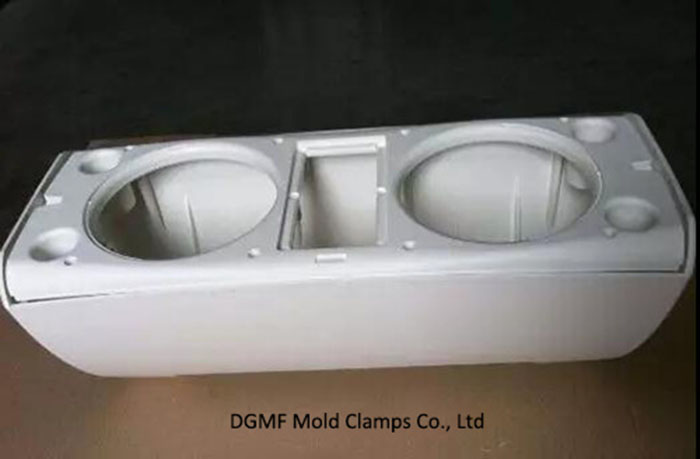After the read, you will learn:
What is under-injection
Why is the molded product under-injection?
How to solve it?
What is under-injection?
There is no need to adjust some under-injection that is not important internally and does not affect the appearance.
Why is the molded product under-injection? How to solve it?
There are many reasons for under-injection, mainly in the following 12 situations, and 12 tricks to solve the under-injection of injection molded products.
1. Insufficient amount of material or litter.
Adjust appropriately until the parts are completely filled.
2. The barrel temperature is too low.
When the material temperature is low, the melt viscosity is larger, and the resistance is also large when filling the mold. Properly increasing the material temperature can enhance the melt fluidity.
3. The molding injection pressure or speed is too low.
The filling process of the molten material in the injection mold cavity lacks sufficient driving force to continue to flow to the remote. Increase the molding injection pressure, so that the molten material in the cavity can always be fully replenished with pressure and quantity before condensing and hardening.
4. Insufficient injection molding time.
It takes a certain amount of time to inject a complete part of a certain weight. If the time is insufficient, it means that the injection molding volume is insufficient. Increase the injection molding time until the part is fully filled.
5. Improper packing.
The main reason is the premature pressure transfer, that is, the holding pressure switching point is adjusted too large. The remaining amount of material is supplemented by the holding pressure, which will inevitably make the weight of the part insufficient and under-inject to make the parts complete.
6. The injection mold temperature is too low.
When the shape and thickness of the workpiece vary greatly, the excessively low injection mold temperature will consume too much injection molding pressure, appropriately increase the injection mold temperature or reset the mold water channel.
7. Poor coordination between the nozzle and the injection mold gate.
During injection molding, the nozzle overflows and some of the material is lost. The injection mold is readjusted to make it fit well with the nozzle.
8. The nozzle hole is damaged or partially blocked.
When the seat is selected for retreat, the injection nozzle and the injection mold will continue to collide for a long time, which makes the injection hole smaller gradually, that is, the material flow channel becomes smaller, and the area-specific volume of the material bar increases, which will cause the cold material to block the nozzle hole, Or consume too much injection molding pressure.
The nozzle should be removed for repair or cleaning, and the forward end position of the shooting seat should be properly reset to reduce the impact force to a reasonable value.
9. The rubber seal ring is worn.
The wear gap between the check ring and the thrust ring on the screw head is large, and it cannot be effectively cut off during injection molding so that the molten material that has been measured at the front end generates reverse flow, and the injection mold component is lost, resulting in incomplete parts.
The rubber seal ring wear method has been verified: after the last cycle of injection molding is completed, it will switch to manual operation mode, adjust the injection molding pressure and speed to a lower value, and then execute the storage.
At this time, observe the degree of obstruction of the progress of the screw position indicator when performing glue injection molding manually, that is, check the degree of leakage through the rubber ring. The less obstructed, the greater the degree of leakage.
The rubber seal rings with a large degree of wear should be replaced as soon as possible. Otherwise, the production will be barely carried out, and the product quality cannot be guaranteed.
10. The poor exhaust of the plastic injection mold.
During the injection molding process, the air in the plastic injection mold cavity is too late to be discharged from the parting surface or the thimble gap, so that the last molten material is blocked by the continuously compressed high air pressure in the plastic injection mold cavity, leaving the end of the material flow blocked and unable to Defects infusion.
Moderate exhaust passages are set up on the parting surface corresponding to the gas barrier position. If the air blocking position is not on the parting surface, the original sleeve or thimble can be used to change the internal exhaust, or the gate position can be reselected so that the air is discharged according to the expected position.
11. The ribs of the parts are too thin or too deep.
These are all dead corners where the air is easily stored, and where a filling is difficult. Thicken the ribs or increase the arc angle of the root. The most thorough method is to add exhaust measures.
12. Uneven distribution channel or gate channel.
Due to the continuous improvement of the plastic injection mold manufacturing technology and design level, the design of the single-head mold runner is mostly reasonable and meets the molding requirements.
This refers to the multi-cavity flow channel distribution. There are often slight differences between the gates, which will lead to uneven flow components injected into each cavity, causing some cavities to fill up and some cavities still underfill.
You may also be interested in the below articles:
Summary Of 50 Injection Mold Structure Operation Dynamic Diagrams




